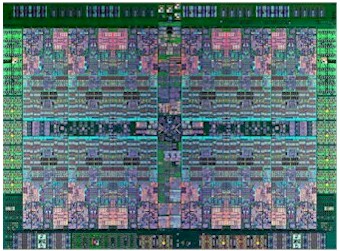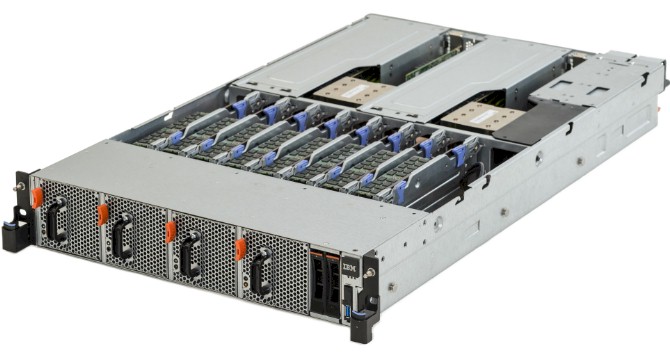OpenPower Systems Coming In Mid-2015

The ecosystem for Power Systems machines is building faster than many might be expecting, and it looks like a bunch of new machines will be coming to market by the middle of next year that are based on designs from vendors other than IBM. This, and the possibility that Big Blue and its OpenPower Foundation partners will put out a long-term Power processor roadmap, should go a long way toward convincing the systems space that IBM is committed to opening up the Power platform and seeing it grow through an ecosystem and provide an alternative to X86 machinery.
The foundation is also going to host its first OpenPower Summit in March in Santa Clara, concurrent with Nvidia's GPU Technology Conference.
Brad McCredie, an IBM Fellow and former chip designer who set up the OpenPower Foundation and who is its first president, tells EnterpriseTech that there are twelve partners out of the more than 75 companies that are part of the foundation who are building their own systems. Many of the companies have not revealed their identities as yet, but as we previously reported, Tyan has created a single-socket board for Power8 development systems and Google has forged its own two-socket system board to run its own internal tests. IBM, of course, makes its own Power8 motherboard and systems, but if the ecosystem evolves sufficiently, Big Blue could decide to use the motherboards of other suppliers in its commercial-grade Power Systems server line.
"As we expected, 90 percent of these OpenPower systems are addressing the scale-out and Web 2.0 market, and we have a lot of traction in that space," says McCredie. "A few of them are doing scale up, and we are helping them with a few things. We believe that having more market presence will help our customers and will help everybody grow that space. We are addressing scale up and scale out, but the bulk of our partners are in the scale out marketplace. We are building the pyramid, with a broad base with companies addressing scale out with white boxes, and IBM has a very strong set of scale out machines that I will call black boxes. And IBM has scale up machine on top of that. But we are making sure there is OpenPower participation up and down that pyramid that is sound and robust and can provide growth for everybody."
Most of the future OpenPower scale-out machines are based on two-socket designs, but one is for a single-socket system. There is a mix of rack servers as well as hyperscale designs with half-width and full-width sleds, as is common in modern hyperscale and some commercial datacenters and supercomputer centers. These machines are designed to run Linux, and IBM does not expect them to support its own AIX and IBM i operating systems. (Machines that are badged by IBM could end up supporting either, should this be desirable for Big Blue.) McCredie said that he expects for the first commercial Power8 systems that come out of the OpenPower effort and that do not have IBM badges on them to hit the market in the middle of 2015, and he was then even more precise and said the expectation was for announcements to come in June.
To whet the appetite for these future Power8 machines a little, McCredie showed EnterpriseTech a little preview of a machine that is being created by Wistron, one of the big original design manufacturers in Taiwan that sells machines compatible with Facebook's Open Compute Project under the Wiwynn brand.
The machine above is a two-socket Power8 machine that has eight of homegrown Wistron DDR3 memory cards, complete with the "Centaur" memory buffer chips from IBM that sport 16 MB of L4 cache memory per card. The Wistron machine supports up to 1 TB of memory using 32 GB memory sticks. Specifically, each riser card in the machine supports four standard 32 GB memory sticks. The Power8 socket supports eight memory cards, but Wistron is only doing four per socket. So a two-socket machine using 32 GB sticks with 128 GB per riser card hits 512 GB per socket. (For comparison, IBM has just shipped a 128 GB card for its own Power Systems S824 system that lets a two-socket Power8 machine support 2 TB of main memory.) The Wistron system has 230 GB/sec of memory bandwidth. Wistron is supporting Power8 chips with 8, 10, or 12 cores; clock speeds were not divulged.
The system has only two small form factor (2.5-inch) SATA disks for local operating system storage and has a total of five PCI-Express 3.0 slots. There are two x8 slots and one x16 slot, all three of which are half height, half length. Two other x16 slots are full height and full length and are designated to support a 300 watt Tesla K80 GPU accelerator card from Nvidia, as you can see from the image above. Four of the PCI-Express slots on the Wistron system are enabled with IBM's Coherent Accelerator Processor Interface (CAPI) ports, which allow for the memory protocols of the Power8 chip to ride on top of the PCI-Express bus and allow virtual addressing between the peripherals and the processor complex. In the picture above, the Wistron system has a network card from Mellanox Technologies, and it is very likely one of its ConnectX-4 InfiniBand cards, which runs at 100 Gb/sec but neither IBM nor Wistron is saying.
You might notice something else about this system above. The pictures show it with an IBM logo. That is because Wistron and IBM will both be selling variants of this machine when it comes out next year. IBM's own Power S824L system has two Power8 processors, but it comes in a 4U enclosure instead of a 2U chassis like the Wistron machine and is therefore a little less dense. IBM's Power S824L (a Linux-only machine) does not yet support the larger 2 TB main memory that is available in the Power S824, but it comes with one or two Tesla K40 GPU accelerators, which have half the floating point oomph as the Tesla K80.
As EnterpriseTech has been suggesting, and no doubt many OpenPower Foundation partners are arguing for, IBM is considering putting out a long-term roadmap for the Power processors going out into the future. The idea is to demonstrate the commitment that IBM and its partners have to the processor. (This is precisely what Oracle did right after acquiring Sun Microsystems, and to its credit, the roadmap from five years ago that Oracle put out was pretty much what the company did as it launched its Sparc processors over the past half decade.)
Thanks to the $325 million deal to build the "Sierra" and "Summit" Power9-Tesla GPU hybrid systems for the US Department of Energy, everyone knows that Power9 is coming in 2017. We all expect a Power8+ kicker, which will have support for the NVLink GPU and CPU point-to-point interconnect from Nvidia as well. It is not clear if the Power8+ and the Power8 will share the same sockets, and McCredie was not revealing any secrets today about that. It would be good for system builders if they shared a common socket, but the electronics of the NVLink interconnect might not allow that, and the benefits are so great with NVLink that it is worth altering a motherboard and a system to take advantage of it.












